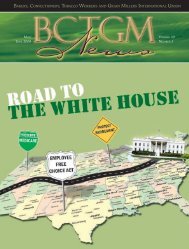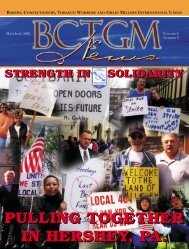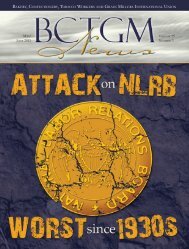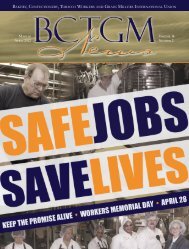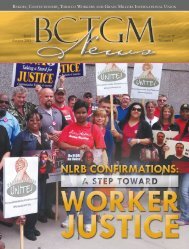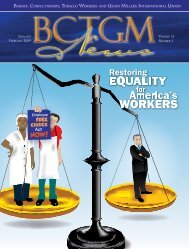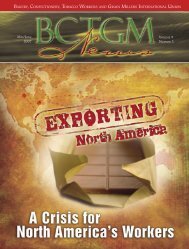to view/print. - Bakery, Confectionery, Tobacco Workers and Grain ...
to view/print. - Bakery, Confectionery, Tobacco Workers and Grain ...
to view/print. - Bakery, Confectionery, Tobacco Workers and Grain ...
Create successful ePaper yourself
Turn your PDF publications into a flip-book with our unique Google optimized e-Paper software.
The S<strong>to</strong>ry of San Francisco Sourdough Bread<br />
“Lac<strong>to</strong>bacillus Sanfrancisco” may<br />
not sound like a precious commodity, but it’s<br />
the secret ingredient first discovered in San<br />
Francisco in 1849 that makes the city’s sourdough<br />
bread world-famous.<br />
Using bread “starters”—an ancient method<br />
of making bread with a fermented mixture of<br />
flour, water, <strong>and</strong> yeast—was common practice<br />
in the 19th century. Miners purchased such<br />
starters in San Francisco <strong>and</strong> carried them on<br />
their treasure-seeking journeys <strong>to</strong> the Sierra<br />
foothills, where they baked loaves with a<br />
unique, sour tang found nowhere else in the<br />
world. Their sourdough bread was so much a<br />
part of the culture that seasoned prospec<strong>to</strong>rs<br />
came <strong>to</strong> be known as “sourdoughs”—having<br />
long fermented in the mines.<br />
A group of wild microorganisms, which<br />
thrive only in the Bay Area’s unique climate,<br />
work <strong>to</strong>gether in a feat of culinary science <strong>to</strong><br />
produce the unparalleled bread. While most<br />
breads are leavened using a single genetic<br />
strain of commercial yeast, sourdough relies<br />
on these wild microorganisms for leavening as<br />
well as flavor. Using a bowl of flour <strong>and</strong> water<br />
as bait, the baker makes a starter by capturing<br />
yeasts <strong>and</strong> bacteria (including lac<strong>to</strong>bacillus<br />
sanfrancisco) from the air, the mixing bowl<br />
itself, even the baker’s h<strong>and</strong>s.<br />
Feeding on the flour, these microorganisms<br />
begin <strong>to</strong> multiply. The yeasts give off<br />
carbon dioxide, which makes the dough rise,<br />
while the bacteria produce lactic acid <strong>and</strong><br />
acetic acid (vinegar), which contribute the<br />
sour flavor. Once the dough is made, a bit of<br />
it is folded back in<strong>to</strong> the unused portion of<br />
the starter, providing sustenance for the<br />
ever-growing microrganisms, which is henceforth<br />
known as “the mother loaf.” Fed a regular<br />
diet of flour <strong>and</strong> water, this mother<br />
strain continues <strong>to</strong> multiply, creating new<br />
“babies” every day, producing descendents<br />
indefinitely. In fact, BCTGM Local 24 members<br />
at the Parisian <strong>Bakery</strong> in San Francisco<br />
still use the same “mother” strain that was<br />
created more than 120 years ago.<br />
While sourdough breads have been made<br />
throughout the world, San Francisco’s sourdough<br />
is widely regarded as the best in the<br />
world. Today, Local 24 members continue<br />
the his<strong>to</strong>ric formula at the San Francisco<br />
French Bread Company, producing the<br />
world-famous breads under the Parisian,<br />
Toscana <strong>and</strong> Colombo names.<br />
Pictured on these pages are Local 24<br />
members at the Parisian plant in San<br />
Francisco who remain dedicated <strong>to</strong> art of<br />
baking San Francisco’s best-loved breads.<br />
10<br />
BCTGM News<br />
September/Oc<strong>to</strong>ber 2004 www.bctgm.org 11



